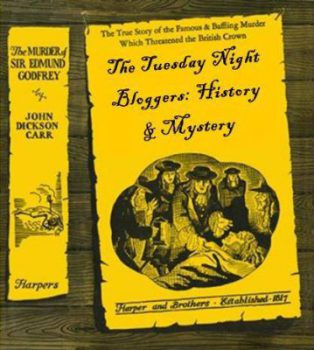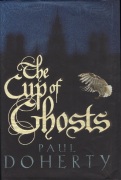 Good evening and welcome to this inaugural lecture in a series of Murder Throughout History. “By his deeds shall a man be known” said the rapper VC (apparently) although the Bible did get there first. Well, by the deeds shall a country be known, so we are going to look at the history of medieval England, and its surroundings through the murders, as documented by recent historians. This series of lectures is my first venture into what is known as The Tuesday Night Bloggers, all of which are going to be discussing History & Mystery this month – I’ll provide a link to it once the index page appears.
Good evening and welcome to this inaugural lecture in a series of Murder Throughout History. “By his deeds shall a man be known” said the rapper VC (apparently) although the Bible did get there first. Well, by the deeds shall a country be known, so we are going to look at the history of medieval England, and its surroundings through the murders, as documented by recent historians. This series of lectures is my first venture into what is known as The Tuesday Night Bloggers, all of which are going to be discussing History & Mystery this month – I’ll provide a link to it once the index page appears.
As a starting point, we are going to take the traditional approach of using 1066, although despite there being strong rumours of an invasion or two at that point, we haven’t got any evidence of that. However in 1086, there is some evidence, courtesy of Edward Marston, that murder was taking place as two of King William’s census takers stumble across a series of crimes while helping to compile the Domesday Book. It should be said that this researcher has yet to examine the evidence presented here, but it seems that the country’s next monarch, William II, presided over only a single murder, that of himself – as detailed by eminent historian Dr Paul Doherty in “The Death Of The Red King”.
 The next fifty or so years was utterly crime-free, including the reign of Henry I. It was only when Stephen took the throne ahead of Matilda, and civil war broke out, that murder reappeared, mostly based around Shrewsbury. Luckily for the state of the nation, not only was there a crime-solving monk (Brother Cadfael) in the vicinity but for every murder, at least one monk or nun found true love, so that’s nice.
The next fifty or so years was utterly crime-free, including the reign of Henry I. It was only when Stephen took the throne ahead of Matilda, and civil war broke out, that murder reappeared, mostly based around Shrewsbury. Luckily for the state of the nation, not only was there a crime-solving monk (Brother Cadfael) in the vicinity but for every murder, at least one monk or nun found true love, so that’s nice.
 After Stephen was succeeded by Henry II, murder was still scarce in the country, with only a few instances occurring, but luckily Adelia, the Mistress Of The Art Of Death, was around to sort them out. Once Richard I takes the thro
After Stephen was succeeded by Henry II, murder was still scarce in the country, with only a few instances occurring, but luckily Adelia, the Mistress Of The Art Of Death, was around to sort them out. Once Richard I takes the thro ne, and spends most of his time out of the country, the body-count starts to pile up. Murders start taking place in more than one location – in Exeter, as dealt with by Crowner (Coroner) John de Wolfe, as documented by Bernard Knight and
ne, and spends most of his time out of the country, the body-count starts to pile up. Murders start taking place in more than one location – in Exeter, as dealt with by Crowner (Coroner) John de Wolfe, as documented by Bernard Knight and  near the Hawkenlye Abbey as documented by Alys Clare. Murder seemed to be about to sweep the nation…
near the Hawkenlye Abbey as documented by Alys Clare. Murder seemed to be about to sweep the nation…
 But surprisingly, when King John (who was, despite some sources, not a thumb-sucking lion) took the throne, clearly everyone was focussed on what a terrible king he was and murder stopped. The next documented murder takes place in Oxford in 1264, forty-eight years into the reign of Henry III. William Falconer, as docume
But surprisingly, when King John (who was, despite some sources, not a thumb-sucking lion) took the throne, clearly everyone was focussed on what a terrible king he was and murder stopped. The next documented murder takes place in Oxford in 1264, forty-eight years into the reign of Henry III. William Falconer, as docume nted by Ian Morson, was on hand to sort that out, but Henry was clearly losing the plot in his old age, as murder returned to East Anglia near the priory of Tyndal, as documented by Priscilla Royal.
nted by Ian Morson, was on hand to sort that out, but Henry was clearly losing the plot in his old age, as murder returned to East Anglia near the priory of Tyndal, as documented by Priscilla Royal.
And then Edward I takes the throne, and we have the first instance of murder  flaring up all around the country, as Hugh Corbett, Keeper of the King’s Seal (as documented by Paul Doherty), goes hither and thither about the country solving all sorts of murders, even getting as far as Scotland, and even solving some problems from the past such as the fate of Robin Hood or the location of King John’s treasure. It should be noted that the frequency and complexity of murders seems to escalate as his career progresses. This is probably nothing to do with Doherty needing to keep his most popular character in the era of Edward I, given that he had started a second series set early in his successor’s reign.
flaring up all around the country, as Hugh Corbett, Keeper of the King’s Seal (as documented by Paul Doherty), goes hither and thither about the country solving all sorts of murders, even getting as far as Scotland, and even solving some problems from the past such as the fate of Robin Hood or the location of King John’s treasure. It should be noted that the frequency and complexity of murders seems to escalate as his career progresses. This is probably nothing to do with Doherty needing to keep his most popular character in the era of Edward I, given that he had started a second series set early in his successor’s reign.
 And Edward II’s reign is another busy one. Edward, it seems, can’t decide who’s going to investigate what. Mathilde of Westminster, in response to the persecution of the Templars, comes to England and solves a couple of court-related murders for him, before Corbett sorts out the affair of the Dark Serpent, only for Mathilde to return for the case of The Darkening Glass, with no mention of Corbett. This is slightly odd, due to both investigators being documented by Dr Paul Doherty – one wonders if, as more tales of Hugh are unearthed, that we find an alternative fate for Edward’s favourite, Piers Gaveston.
And Edward II’s reign is another busy one. Edward, it seems, can’t decide who’s going to investigate what. Mathilde of Westminster, in response to the persecution of the Templars, comes to England and solves a couple of court-related murders for him, before Corbett sorts out the affair of the Dark Serpent, only for Mathilde to return for the case of The Darkening Glass, with no mention of Corbett. This is slightly odd, due to both investigators being documented by Dr Paul Doherty – one wonders if, as more tales of Hugh are unearthed, that we find an alternative fate for Edward’s favourite, Piers Gaveston.
 After this turmoil close to the King, murder returns to Exeter as detailed by Michael Jecks, with more fallout from the Templar persecution. The investigators in question, Sir Baldwin Furnshill and Bailiff Simon Puttock, do seem to be the focal points for murder in this instance, rather than the locale, as they also find murder in Galicia, the Scilly Isles and in the court of the King. But mostly around Exeter…
After this turmoil close to the King, murder returns to Exeter as detailed by Michael Jecks, with more fallout from the Templar persecution. The investigators in question, Sir Baldwin Furnshill and Bailiff Simon Puttock, do seem to be the focal points for murder in this instance, rather than the locale, as they also find murder in Galicia, the Scilly Isles and in the court of the King. But mostly around Exeter…
This brings us to 1327, the deposition of Edward II, who was himself apparently murdered (although Dr Doherty has an alternate theory.) It seems up to this point, murder seemed to happen in small localised outbursts around the country. I am sure that there are plenty of undocumented killings, but interesting murder seemed very localised both in place and in time. This is a demonstration of what is known as the Batman Effect where, in the presence of an effective crime fighter, the criminal raises their game to combat the threat, rather than clearing off to somewhere that won’t attract someone who will thwart their plans.
Of course, the paucity of murders in this period reflect the knowledge of the time. If you were to ask the average man in the street what happened after the Battle of Hastings, then, if the answer isn’t “What’s the Battle of Hastings?”, then you might get the phrases “Domesday Book”, “Crusades” and “Magna Carta” and it’s very unlikely that these phrases could be expanded upon. If you mention Edward II, you might hear how he met his end, but not much else. Hence the unwillingness to write in this era due a general unfamiliarity with it, which is a shame as through tales of grisly murder, we can learn more about the past than we would through any whistle-stop tour of the medieval period from school. My impression is that there is a reluctance to sample a world which the reader has basically no knowledge of.
Many authors are skilled at weaving a compelling mystery novel set in the past but, judging from comments that I’ve received, many readers are reluctant to step further back into the past than the Downton Abbey era, if that. I don’t want to bang on yet again about the wonders of Messers Jecks and Doherty, but if you’re one of those readers who wants a change from “Chapter One: The dead girl in the alley…”, take a chance and look back in time. A chance for motives to be less obvious, a chance for a good reason why the police forensics department didn’t catch the killer, a chance to immerse yourself in a world both familiar and unfamiliar at the same time, a chance to learn something new… such as not living in Exeter should you find yourself back in the past – it’s full of murderers!
Anyway, next week, I’ll take a look at the Hundred Years War, The Wars Of The Roses and I might even get round to a Tudor or two…

Great post (who knew King John wasn’t a lion?) and hooray for joining in with the Tuesday Night Bloggers! I’ve added a link to the Facebook post where the links get collected. Looking forward to your next TNB post. It’ll be interesting to see which mystery novels you pick as based on my sisters’ book shelves the late Medieval/Tudor period is quite a popular time period for setting novels.
LikeLike
Not wishing to spoil my post, but it’s not until we hit the Tudors that there becomes a slew of mystery novels – romanticisation of history is more common. But I need to do a little more research first.
As far as I’m aware, these are the main examples of the genre for this period – it’s less of a choice, rather than all that I’m aware of…
LikeLike
I just KNEW you’d be a part of this topic, P.D.! It was written in the annals . . . 🙂
LikeLike
Doc, its great to see you indulging in these more analytical posts…not knocking your reviews, of course, but you write these kinds of overviews so well (and, with 1000 posts of practice, I should bloody well hope so…!). I have my eye on a Doherty book for next week, as it happens, and I’m greatly looking forward to getting back into him — still not sure what’s taken me so long.
Anyway, rally looking forward to the future posts on this topic 🙂
LikeLike
Many thanks, JJ. One of the reasons that I tend to stay away from this sort of thing is that my reading (and memory) isn’t wide enough to tackle a topic that I’m less familiar with – if something grabs my attention, then I’ll turn my mind to it, but I won’t spend time on, say, a long discussion on Sayers or Allingham that would require research. But historical mystery fiction? Count me in.
LikeLike
This is the perfect topic for you and you do it so well. I have learned a lot from you about these types of mysteries in all the time I have been reading your blog. Thanks so much.
LikeLike
Great list of titles! and it sounds that that’s not all off it! :))
LikeLike
What a great review of the literature – knowledgeable, all-embracing, and funny too.
LikeLike
Cheers, Moira. Glad you enjoyed.
LikeLike
[…] – The Mystery Of History; Bodies From The Library 2016; Some thoughts on Bias In Blogging; Parts 1, 2 and 3 of my trawl through medieval-set crime fiction; The ridiculously hard 1000th Post […]
LikeLike